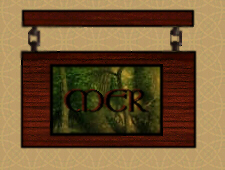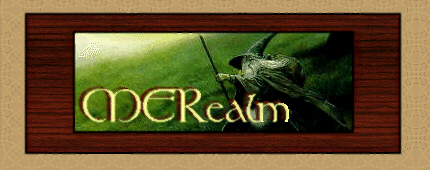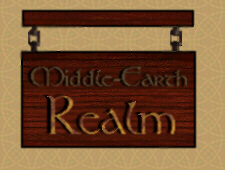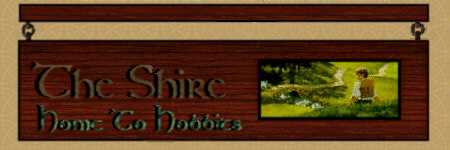|
|
|



|
|
Without thoust, knowledge you
lead your life without knowing, where you stop.
-Anafdune |


Middle-earth is the world created by Professor J. R. R. Tolkien in The
Lord of the Rings, the Hobbit and other works. Yosemite Entertainment
is creating a living, breathing interpretation of this world as a massively
multi-player Internet game, where thousands of players will be able to
explore and enjoy the beauty and danger of Tolkien’s creation.
When can I play the game?
We expect to begin beta testing for Middle-earth around 3rd quarter 1999.
How many players will be in the game at one time?
We will support 10,000 players simultaneously in one world.
Will it be one world, or several ?
An additional copy of the world will exist for each 10,000 players we support.
Will there be a single player version of the game?
No. Middle-earth has been designed as a massively multi-player Internet game only.
What type of computer will I need for Middle-earth?
Our expected minimum requirements are a 300 MHz Pentium-class processor
with a Direct3D compliant graphics accelerator, 32 MB of RAM,
and 500 MB free hard drive space. Be aware that these specifications are
expected to change.
Will I need a 3D video card?
Yes. Any contemporary Direct3D compliant graphics accelerator should provide acceptable gameplay.
Is the game played over the Internet?
Yes. You will require an Internet connection to play.
What will it cost to play the game?
We haven’t decided quite yet. We are currently evaluating pricing plans to see what is financially viable.
What is the perspective – 1st person or 3rd person?
The game perspective is from a 3rd person overhead view.
What parts of the game are 3D? Which parts are 2D?
The game engine is a 3D polygon engine. All terrain and avatars are constructed of polygons with shading and 3D lighting effects.
How does the Camera work?
By default the Middle-earth camera will center on the player and view the
action from an isometric point of view. The player can chose to rotate
the camera on the horizontal and vertical planes in order to ensure a good
point of view at all times. It is also possible to zoom out to see more
of the room.
Will Middle-earth support 3DNow and Katmai technology?
Yes. It remains to be determined how much of a performance improvement these enhancements deliver.
How many beta testers are you going to have? When? Is it a public or closed beta?
We haven’t decided just yet.
When can we see some real screenshots?
Real soon now!
What about these French screenshots?
The screenshots printed in the French magazine Joystick and subsequently
posted on several web sites were not game screenshots, but
mock-ups created by the art team using prototype sprite artwork. We’ve
since discarded this approach in favour of completely real-time 3D
polygon characters and environment, so the entire look will be quite different.
Why isn’t there a Mac port planned?
Unfortunately, because of the cost and added complexity involved in developing
and continuing to develop, upgrade and support multiple client
platforms, we are unable to commit to delivering the Middle-earth client
on platforms other than Windows.
This decision is not based on any partisan opinion of the merits of a particular
operating system, platform or company. It is simply a practical
necessity; creating Middle-earth for one platform is a Herculean task in
itself. Cross-platform development of the constantly evolving client
software would complicate this task to the extent of jeopardizing our efforts.
Once Middle-earth has launched and the client is stable a port becomes
more practical, particularly if a credible developer were to make an
approach.
What stage of development are you at?
We have the majority of the game engine and framework ready, and are beginning
to develop the gameplay mechanics, the combat and skills
systems and so forth. Our planned Beta is still on target for next year,
and we will ensure that there is at least a six month Beta test period.
Game Overview
How big will Middle-earth be?
Middle-earth will consist of approximately 20,000 ‘rooms’. Each room is 3200x3200 pixels, roughly 20 screen-sized areas.
How will travel be implemented?
You will be able to travel by horseback or on foot. There will not be any
teleportation or ‘recall’ spells available, as these things are
inconsistent with the Tolkien universe.
How long will it take to get from the Shire to Rivendell by foot?
Approximately a half-hour, if you were travelling in a straight line and
you weren’t interrupted. To get from one side of the continent to
the other would take more than an hour.
Is the Middle-earth world to scale?
No, it would be impractical to create a Middle-earth game to ‘real’ scale;
we do not consider it feasible or entertaining to make players
spend weeks of real time walking across the map. Middle-earth has been
designed to be a very large game, but not so big as to be dull
or desolate.
Will I be able to own property?
Every character will begin with a house in a location dependant on the
race of the character. You will be able to relocate to a new city as
well. Additionally, guilds will be able to buy (and sell) specific buildings
set-aside for that purpose.
Can I decorate it?
Yes. You will be able to place and move furniture in your house. There
will also be upgrades that can be purchased for your house to
make more rooms available.
Is harvesting raw materials part of the game?
Yes, but only insofar as collecting the appropriate ingredients for actions such as preparing foods, spell-casting, alchemy and healing.
Will I be able to own animals?
Yes. You will be able to have a house pet (a cat or a dog for example) and be able to tame wild beasts.
What can you tell us about the story?
Our Middle-earth is set many generations into the Fourth Age, after the
War of the Ring. Though the world of Middle-earth has largely
been at peace since the fall of The Lord of Rings, as Gandalf reminded
the captains of the west, ‘Other evils there are that may come;
for Sauron is himself but a servant or emissary.’
Rumours come to the free peoples of forces gathering against them, and
Orcs are seen abroad again. But, with these new threats also
comes the aid of the wise, who have not wholly forsaken Middle-earth.
Thus the players of Middle-earth will find themselves in a place of adventure
and peril, at least when they step beyond the carefully
cultivated borders of their comfortable homelands.
Why the 4th age?
We have chosen to set Middle-earth in the 4th age so we can be creative
with the story whilst remaining consistent with the original
works of Tolkien.
Will there be weather?
Yes. Expect rain, snow, and fog to impede your travels.
How much can I customize my characters?
You will be able to customize your characters to the highest degree. You
will be able to create your character’s face from a huge array of
heads, eyes, noses, chins, ears, lips, and hairstyles. There is also a
grand selection of clothing, weapon, and armor types to choose from
when dressing your character. Additionally, clothing options can be dyed
to any color and shade.
What are Houses?
Houses are Middle-earth’s groups of like-minded players. A House can be
organized around a particular profession, skills set, quest or
moral philosophy. Houses act in a similar way to ‘guilds’ in many online
games. We prefer the moniker House as it suits better the world
of Professor Tolkien.
There will be Major and Minor Houses in Middle-earth. Major houses will
occupy a physical property on the map, have a more
permanent place in the world and may be eligible for special abilities
or quests. Minor Houses can be formed more easily, have lower
upkeep and therefore can survive with much smaller memberships. Both types
of House will have certain name restrictions; Major
Houses in particular will have to adopt names suitable to Middle-earth.
What about Family?
Middle-earth will have provision for players to form their own families,
both by marriage and by ‘adoption’. The family forms a small,
compact unit and allows for your inheritance in the event of your permanent
death. Family members can be members of different Houses.
Families share reputation, so poor or excellent behaviour on the part of
immediate relatives can significantly effect the entire family’s
status.
How will I communicate with other players?
Middle-earth will have a full IRC style chat system embedded into the game.
You will be able to locate and converse with individuals or
groups of people in the game wherever they are in the world. Additionally,
there will be hundreds of global ‘gossip channels’ that can be
used for guild or other special interest discussions.
When characters get killed, what happens to them?
They die, permanently. The character ceases to exist. This will be a rare
occasion, however – when a character is bested in combat he
will be ‘knocked out’, stripped of his possessions, and left for dead by
most monsters. Players will have the option of permanently killing
other players, but the penalties for such a hideous act will be dire.
How can you implement permanent death? You must be mad!
Whilst many of us will rue the death of a favourite character, we feel
that mortality will add a weight and importance to your choices in
Middle-earth that is appropriate to the ethics of Professor Tolkien’s world.
It will not be easy to die; most creatures and other players
will refrain from delivering the killing blow, as the advantages of murder
are limited. However, those who risk great battles against terrible
evils will have to accept the severe consequences of failure.
In addition, we have a duty to try to uphold the authenticity of Tolkien’s world, in which repeated resurrection is undesirable.
What about NPCs – who, where, what do they do, can I hire them?
There will be many NPCs in Middle-earth, and they will act with sophisticated
intelligence in their interaction with players. NPCs will
range from notable local leaders, who might provide you with quests or
information, to disgraceful rogues that loiter in the countryside
looking for easy prey. You will find conversation with NPCs useful and
rewarding. Some NPCs will be mercenary, but most will have to
be convinced of your good intentions and high reputation in order to follow
you.
Will there be user-defined shortcuts (macros)?
There will be a specific in-game macro system that will allow you to assign
shortcut keys to often-repeated tasks. The game will not
allow macros to be used for tasks that could be repeated to gain experience
or improve skills.
Why are you having a Global Chat system? How will it work?
Middle-earth will include a chat system allowing players to communicate
with one another over distance. We believe that this is a useful
addition to the game and a requirement to avoid the proliferation of third
party add-on programs.
The ‘global’ chat channels will be geographically restricted, so ‘The Shire’
will have a global ‘gossip’ channel, not the entirety of
Middle-earth. Groups of players, friends and ‘guilds’ will be able to set
up private channels that allow communication across the entire
world.
The chat system will be optional; the use may choose to activate it or
ignore it. We appreciate that chat is not everyone’s cup of tea, but
we prefer to provide such functionality within the game rather than give
an advantage to those who use third-party programs, such as
ICQ or IRC.
How can you hope to ensure that Elves are played consistently?
Some controversy exists over the possibility of great numbers of ‘evil’
and player-killer Elves terrorizing Middle-earth in a manner
inconsistent with the works of Tolkien. Although we cannot reveal much
information on this subject, rest assured that we are working on
methods to contain the Elven population within reasonable bounds of size
and conduct. Be aware, though, that misanthropic deeds on the
part of Elves are not unheard of in Tolkien’s works.
Magic in Professor Tolkien’s works is used sparingly. How will this work in Middle-earth?
As it is made clear in Tolkien’s works, magic is rarely used prominently
in Middle-earth. Our game will reflect this. Temper your
interpretation of the class titles in this FAQ with your understanding
of Tolkien’s world and our commitment to preserving its character;
magic is limited in its availability and subtle in its effects.
Tell me about the environment sound effects in Middle-earth?
We have a full time sound engineer, Tim Larkin, who is dedicated to creating
the most beautiful ambient sounds, fostering an immersive
and exciting atmosphere. Support for Aureal A3D’s system allows us to position
audio sources in three dimensional space.
How will dungeons be created, and what about Moria?
Major underground areas like Moria, Mount Gundabad and so forth will be
real physical locations like any other. Smaller sub-sections
and areas may be ‘spawning’ dungeons, created anew for each party, in a
similar way to The Realm. As with all other things in this
document, is subject to change.
Can you play Evil characters?
Yes, it will be possible to play evil or morally ambiguous characters.
Middle-earth will encourage such nefarious fellows to play roles
within the context of the game, rather than just using their morality as
an excuse for indiscriminate aggression.
Role-Playing System
Is the RPG system skill or class based?
Middle-earth employs a hybrid RPG system, employing the best aspects of
typical skill- and class-based systems. Depending on a
character’s race and profession selections, the character will acquire
a set of skill Affinities, Aversions, and Abstentions. Having an
affinity to a skill denotes that the character will learn the skill quickly
and ultimately achieve a higher ability. Having an aversion signifies
that the character will learn the skill slowly, and having an Abstention
means that the character can not utilize the skill at all.
Can I become super-powerful like Gandalf was?
Experienced players will never become superhuman or godlike in Middle-earth.
They will have a much wider variety of abilities to draw
upon and better chances to succeed at any given task, but they will not
be able to hack apart overwhelming groups of monsters or
players without fear of their own death.
What races will I be able to play?
You can play as a Hobbit, Human, Elf, or Dwarf.
What professions are available?
Your character can be a Warrior, Ranger, Bard, Thief, Healer, Blacksmith,
Barbarian, Brigand, Sorcerer, Enchanter, Assassin,
Alchemist, or Loremaster. Some professions will not be available to all
races, however.
What types of skills are there?
Middle-earth will have, of course, a plethora of skills. From Acrobatics
to Alchemy, each burgeoning young Hobbit, Human, Elf or
Dwarf will have a wide choice of abilities in which to specialize. Naturally
there will be a number of combat-oriented skills, but there will
also be healing, herblore and cookery. Players will be able to make swords,
armour and other items, but will not generally be required to
skin rabbits. Skill in the tongues of other peoples will be a useful asset
to any party. Some skills of magic will be available to some
players; more detail will be released on this with time.
How do I improve my character’s skills?
Middle-earth's RPG system does not use the typical RPG 'leveling' system
to improve skills. There is no generic 'level' that you achieve
after gaining a set amount of experience points.
Each skill will have it's own independent level, increased by practice.
Depending on the skill, achieving a new level will grant success
bonuses when using the skill and allow the character to learn more 'abilities'.
Abilities are the specific end result of skill and knowledge, and can be
gained by first having the proper skill level and then having a
specific NPC (or possibly a guild) teach you. The NPC may require a quest
or a sum of gold to teach you the ability.
As far as improving health and other attributes, there will be many hidden
experience pools that will be contributed to when you gain skill
levels. Gaining a skill level with your sword may make you stronger and
more dexterous. Taking severe damage in combat may ultimately
increase your constitution and health if you survive the experience.
Middle-earth.com Site
Note: This section is about the official site for Middle-earth maintained by Yosemite Entertainment and not about the Middle-earth Vault.
What is Middle-earth.com?
Middle-earth.com is intended as an atlas, or a reflection of the world of Middle-earth that we are creating.
Just as we are approaching the creation of Middle-earth as a careful interpretation
of the great works of Professor Tolkien, we intend
that this place should reflect the beauty and rich history of Middle-earth.
To accomplish this, we have approached our site as we would provide a guide
for a traveler to another land. Each area, or place in the
site reflects a place in Middle-earth. Though we begin with only a couple
of places, every so often a new area will emerge on the site –
will appear on the road – with more information for eager explorers.
Thus, when you can finally come to Middle-earth and explore its beauty
for yourself, you will find this site a guide and mirror of that
place; ever-changing with the dynamic world it reflects.
Can I contribute to Middle-earth.com?
Yes, though we are not accepting contributions yet, there are plans to
allow players to submit suggestions and even major contributions
to the site. This is likely when the game moves into testing and launch,
when we hope citizens of the cities and towns on
Middle-earth.com will use the site as a forum for their growing communities.
Can we have more maps?
Yes, all in good time.
Where are the screen shots?
All in good time, my friend.
Why should I register?
Registered visitors get our email news, letting them know when the site’s
been changed and giving them advance notice of exciting things.
In the future registered users may have the chance to earn prizes of items
from The Mathom-house.
Can I link to you?
Of course. Please use our official link box.
Can I make copies of your images or text for my web site?
We have to say no, aside from those specifically granted, such as the link
box. Please link to us instead. As good web citizens we would
discourage the duplication of bits.
What’s this artwork on the web site? Is this how the game will look?
The website is presently decorated with concept art and paintings; these
are not necessarily accurate reflections of the final look of the
game, particularly when you consider that the game will employ real-time
3D graphics and lighting. Over time we will publish more game
artwork, including characters and locations rendered from our real-time
and high detail models. Right now we’re keeping this material
under wraps.
Where can I find out more about the history of Middle-earth?
Middle-earth is directly based on the world of J. R. R. Tolkien's classic
novels The Lord of the Rings and The Hobbit. These works
were strongly influenced by his greater mythology, exposed in the Silmarillion,
Unfinished Tales and the History of Middle-earth series.
![]()
To
the main page.
This
page is copyright 99 Middle Earth Realm and
1999
JRR Tolkien, nothing on this site be used in whole or hafe without
further
permission by the website owner.